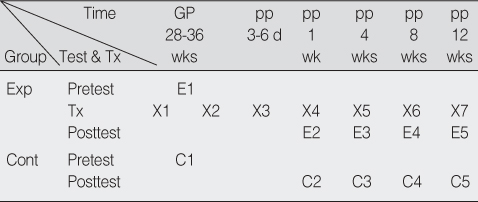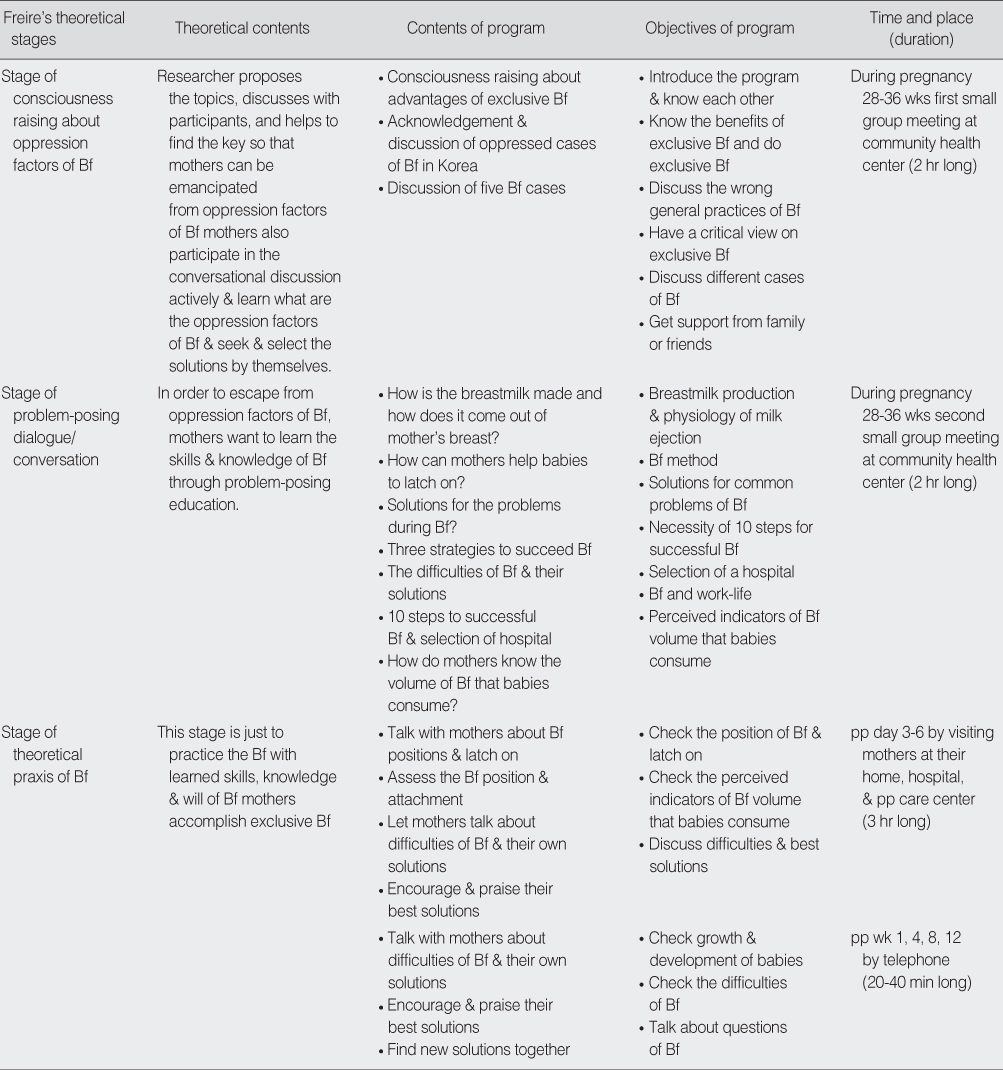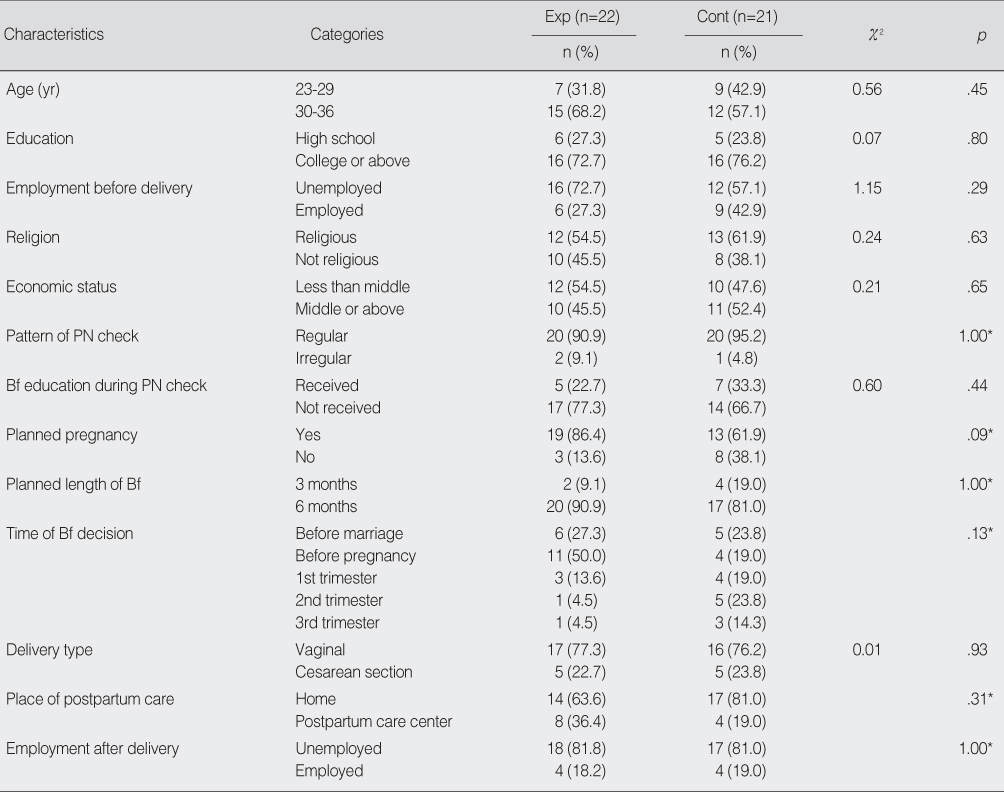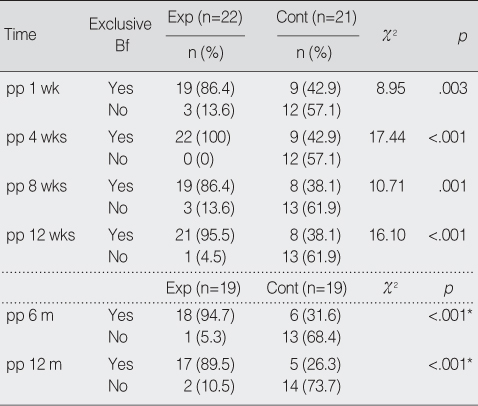Articles
- Page Path
- HOME > J Korean Acad Nurs > Volume 39(2); 2009 > Article
-
Original Article
- Effects of a Breast-Feeding Empowerment Program on Exclusive Breast-Feeding
- Yunmi Kim
-
Journal of Korean Academy of Nursing 2009;39(2):279-287.
DOI: https://doi.org/10.4040/jkan.2009.39.2.279
Published online: April 28, 2009
Part-time Instructor, College of Nursing, Seoul National University, Seoul, Korea.
- Address reprint requests to: Kim, Yunmi. Department of Nursing, College of Nursing, Seoul National University, 28 Yeongeon-dong, Jongno-gu, Seoul 110-744, Korea. Tel: 82-2-740-8465, Fax: 82-2-766-1852, shuregien@hanmail.net
Copyright © 2009 Korean Society of Nursing Science
Figure & Data
REFERENCES
Citations

- A COMPARATIVE STUDY OF DRAINAGE OF BREAST ABSCESS BY CONVENTIONAL INCISION AND DRAINAGE VERSUS SUCTION DRAINAGE VERSUS ULTRASOUND-GUIDED NEEDLE ASPIRATION
ANKIT CHORMA, ARUN KUMAR PARGI, RINKU YADAV
Asian Journal of Pharmaceutical and Clinical Research.2022; : 29. CrossRef - Relationship between emotional labelling of breastfeeding situation and intention to breastfeed/support breastfeeding among French adolescents and young people
Irène Capponi, Françoise Roland
Journal of Public Health.2021; 29(1): 135. CrossRef - Impact of an educational intervention on breastfeeding behaviour among pregnant women
Ali Khani Jeihooni, Seyyed Mansour Kashfi, Pooyan Afzali Harsini
British Journal of Midwifery.2019; 27(1): 33. CrossRef - Comparison of breast feeding practice rates and mothers' breast feeding empowerment in preterm, late preterm and early term infants
Taeim Kim, Gunja Jang
Journal of the Korean Data and Information Science Society.2013; 24(4): 713. CrossRef - The impact of the BASNEF educational programme on breastfeeding behaviour in Iran
Marzieh Akbarzadeh, Nasrin Bahmani, Marzieh Moatari, Saeede PourAhmad
British Journal of Midwifery.2013; 21(4): 276. CrossRef - A Study on the Experience of Breastfeeding Education for Women with Children 24 Months of Age and Younger
Ji-Eun Kim, Dong-Yean Park
The Korean Journal of Community Living Science.2012; 23(4): 523. CrossRef - Effects of Breast-feeding Adaptation, Attitude and Practice of Primipara Depending on Method of Postpartum Breast-feeding Education
Seung Eun Yun, Hyea Kyung Lee
Korean Journal of Women Health Nursing.2012; 18(2): 75. CrossRef - Effects of Breast Massage on Breast Pain, Breast-milk Sodium, and Newborn Suckling in Early Postpartum Mothers
Sukhee Ahn, Jinhee Kim, Jungsuk Cho
Journal of Korean Academy of Nursing.2011; 41(4): 451. CrossRef - Types of Breastfeeding and its Predictors of Mothers in Twenty-four Months after Birth
Miyoung Kim, Sun Hee Kim, Ja Hyung Lee
Korean Journal of Women Health Nursing.2011; 17(1): 21. CrossRef - Applications of the Participatory Learning Process in Health Promotion
Jang-Rak Kim, Baek-Geun Jeong, Ki-Soo Park, Yune-Sik Kang
Journal of agricultural medicine and community health.2011; 36(2): 130. CrossRef

Figure 1
Breast-feeding Empowerment Program
Bf=breast-feeding; pp=postpartum; wk=week(s).
Homogeneity Test for General Characteristics and Other Affecting Factors of Breast-feeding
*Fisher's exact test.
Exp=experimental group; Cont=control group; PN=prenatal; Bf=breast-feeding.
Comparisons of Total & Subscale Scores of Breast-feeding Empowerment between Two Groups at Each Time Point
Bf=breast-feeding; wk=week(s)
Comparisons of Exclusive Breast-feeding between the Two Groups at Each Time Point
*Fisher's exact test.
Bf=breast-feeding; pp=postpartum; wk=week(s); m=months.
Bf=breast-feeding; pp=postpartum; wk=week(s).
*Fisher's exact test. Exp=experimental group; Cont=control group; PN=prenatal; Bf=breast-feeding.
Bf=breast-feeding; wk=week(s)
*Fisher's exact test. Bf=breast-feeding; pp=postpartum; wk=week(s); m=months.
 KSNS
KSNS
 E-SUBMISSION
E-SUBMISSION





 Cite
Cite

